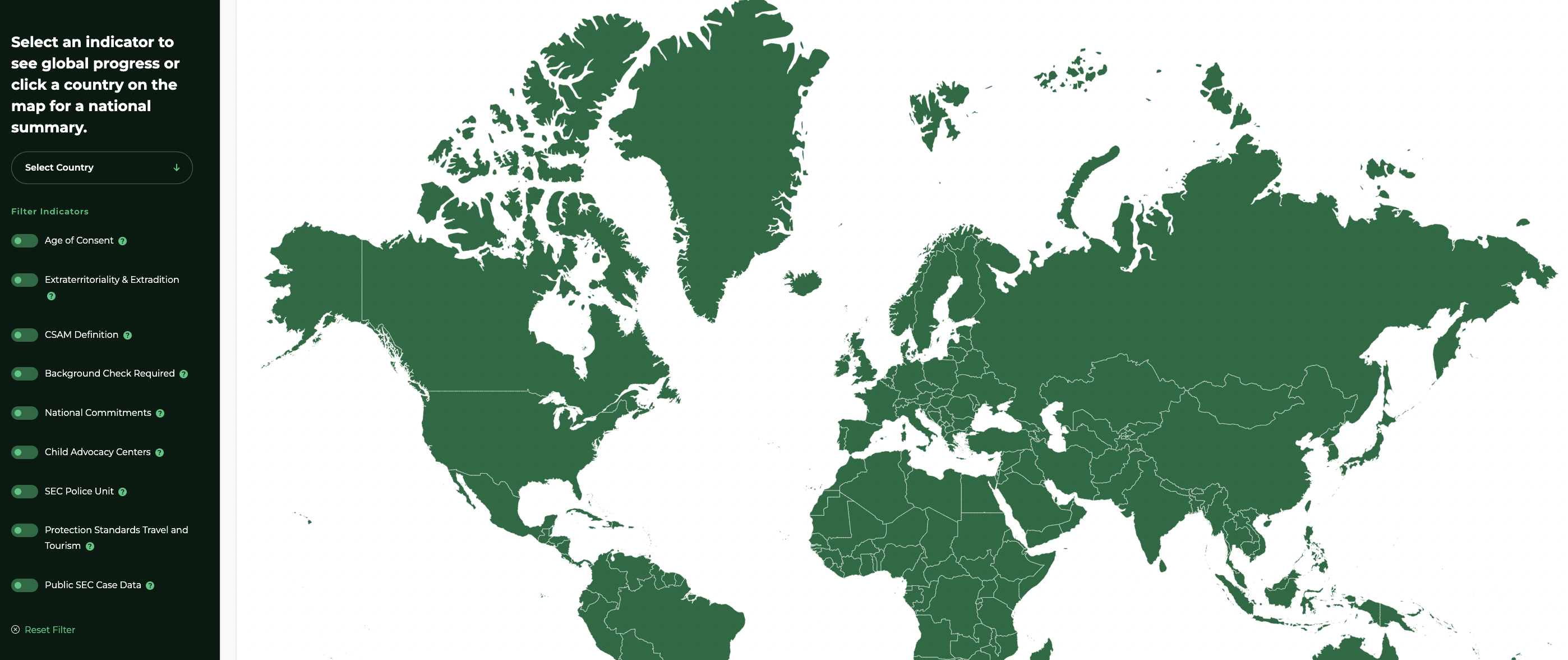No country is immune.
Around the world, each country tackles this issue through their own sovereign laws, policies, and measures. However, it is oftentimes difficult to assess just how effective these diverse measures are.
Harmonising our measurements of the overall global efforts towards ending child sexual exploitation
The sexual exploitation of children is a global issue. No country is immune. Around the world, each country tackles this issue through their own sovereign laws, policies, and measures. However, it is oftentimes difficult to assess just how effective these diverse measures are.
ECPAT’s research team developed the Global Progress Indicators (GPI) as a centralised hub for monitoring and measuring national responses to child sexual exploitation. Visualised as an interactive world map, the GPI currently comprises 9 indicators—ranging from laws to measures—that ECPAT has established as essential to the protection of children.

Collaboration and cooperation are essential to creating positive change on a global scale. With no clear way to measure current efforts to address child sexual exploitation, the GPIs provide key stakeholders such as civil society groups, governments, and child protection professionals, with:
Think of the GPIs as a compass: a guide showing us where we need to be, and what needs to be done to end child sexual exploitation globally.
Think of the GPIs as a compass: a guide showing us where we need to be, and what needs to be done to end child sexual exploitation globally.
ECPAT has carefully selected 9 clearly defined and measurable aspects of any national response towards protecting children. These include:
The GPIs also allow ECPAT members to continue to play their vital role in lobbying for more robust child protection policies in their countries, monitoring government actions, and ensuring up-to-date information is reflected on the GPI map. That is why feedback on the current GPI’s effectiveness and suggestions for new indicators is also a key focus of this project.
As the sexual exploitation of children continues to evolve into various forms, collaboration and cooperation between all stakeholders is essential to enhancing the protection of children worldwide.

Appropriate age of consent laws
Setting the legally defined age at which a person is considered mature enough to agree to sexual activity to 18 years for both males and females. Countries should also set a close in age exemption (up to 3 years) for consensual sexual relationships between adolescents.
Extraterritoriality and extradition provisions for the prosecution of sexual exploitation of children
In cases of child sexual exploitation overseas, countries should have appropriate extraterritoriality and extradition provisions that allow it to exercise authority beyond its territorial limits, and to allow for an offender to be returned by the State where the offender is found to the country where an offence was committed to face prosecution and/or punishment.
Clear legal definitions of Child Sexual Abuse Material (CSAM)
Older terms such as ‘child pornography’ are often misleading and undermines the gravity of these crimes. To be fully comprehensive, the definition of child sexual abuse material should
Strict implementation of criminal background checks
Criminal background checks should be required by law for every national and non-national individual working in positions that involve or facilitate direct contact with children as a requirement of their job, in both public and private settings.


Ensuring international and regional commitments related to sexual exploitation of children
Countries should ratify and implemented key international and regional legal instruments or protecting children from sexual abuse and exploitation, including:
Establishing Child Advocacy Centres
A Child Advocacy Center primarily aims to reduce the re-traumatisation of children by limiting how many times they have to speak about their traumatic experience by coordinating the professionals who may need to have contact with the child. ECPAT recommendations that at least one Child Advocacy Centre should be established in every country.
Dedicated national police units that include sexual exploitation of children crimes in their mandate
States should establish and fund dedicated police units that specifically include in their mandate to investigate crimes of child sexual exploitation occurring within both national and extra-territorial jurisdictions.
Establishing child protection standards for the travel and tourism industry
Businesses in the travel and tourism industry are in a unique position to identify the most vulnerable and to prevent the crime of sexual exploitation of children. Clear legal obligations should be set for travel and tourism companies to take an active role in eradicating these crimes.
Publicly available national data sets on child sexual exploitation cases
National level data is needed to effectively direct efforts to address the sexual exploitation of children. Such data may inform prevention efforts, legal and policy development for the punishment of perpetrators, and the provision of quality support services for children who have experienced sexual exploitation.
